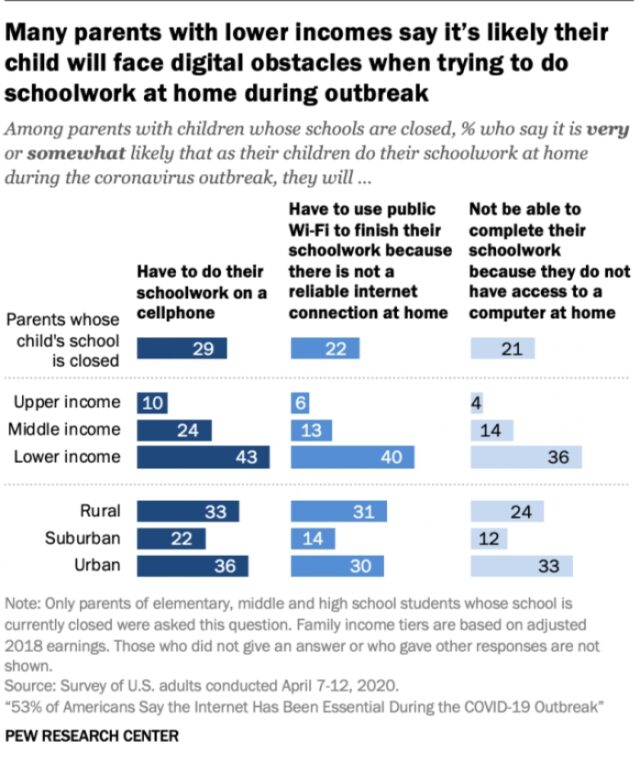
The pandemic has driven most social and commercial activities online, and for many people and organizations, the Internet has become a crucial link to those they had to connect with. The Pew Research Center conducted a survey that concluded that 53% of adult Americans consider that the Internet is essential during the pandemic.
Access to high-speed Internet is a crucial part of modern life, especially as people practice social distancing due to the COVID-19 outbreak. As the pandemic kept people apart, broadband technologies enabled them to work, buy groceries, pay bills, learn, seek jobs, and stay in touch with their friends and family. People are also making great use of telehealth using platforms that allow them to see a doctor without leaving their house. For those fortunate enough to have a reliable connection, the Internet provides a link to information that allows them to stay safe and healthy during a health crisis. With most countries practicing social distancing, everyone is living online. From school classes to religious services, everything can be streamed to those in physical isolation.
But for those who couldn’t access the Internet or with limited access, these last months were dreadful because the pandemic disconnected them from everything they called normal life. Digital inequality and restrictions deprive billions of people of this essential connection. The pandemic exposed the digital limitations that exist around the world. 54% of the global population can use a broadband connection, with people in more impoverished areas or located in politically controlled countries being less likely to access internet resources freely. Also, the elderly, individuals living in remote and rural places, and women are more likely to be online. Even in the USA, 18 million people live in areas without internet access. Ethnic and racial minorities, seniors, and people with limited income or education are less likely to have an internet subscription. And among the people who are online, many are connected only via school, workplace, or public spaces that offer access. The closure of these spaces pushed more people offline.
During a public health emergency as a pandemic, access to the Internet is more than essential because it protects people’s health, human rights, and even economic and social rights. A lack of Internet or restricted access can impact their lives because the Internet provides them with vital information about the coronavirus outbreak and the methods they can use to protect themselves against the virus. With so many people socially distancing or living under quarantine conditions, technology is the only tool that helps them communicate, work, and shop. A significant number of activities shifted to the online medium, ranging from educational programs to health services.
The lack of connectivity or infrastructure is the leading cause that leaves some communities behind, but it’s not the only one to support the digital divide.

What factors trigger a lack of access to the Internet during the pandemic?
Government shutdowns
In some areas, the governments decided to shut down the Internet to keep people offline. Countries like Bangladesh claim that they shut down the Internet because of security concerns with the mobile internet connection in refugee camps. Myanmar also shut down the Internet in nine towns to slow down the spread of information. While in some countries, this happened before the pandemic, in others such as India, the government obstructed the population’s access to the information after the coronavirus outbreak to prevent panic. If you want to read more about the countries that deal with internet censorship or lack of access to the Internet during the pandemic, check this reliable data about the situation.
Poor digital infrastructures
An undeveloped digital infrastructure prevents people from connecting to the Internet or using the services a high-quality connection would provide. This is usually the case for developing countries that lack developed fixed infrastructure. But the existence of adequate infrastructure can even vary from a region or town to another. For example, even if in the USA most households in cities have access to high-speed Internet, 27% of rural properties lack access to it. Sometimes even in well-connected areas, high-speed Internet isn’t affordable for the average individual.

Exclusion of come groups
Some groups and communities have been historically excluded from the use of modern digital technologies and the Internet. For example, in Mexico, the peasant and indigenous communities that make 25% of the total population cannot access the Internet. They don’t face only the lack of infrastructure but also cultural, social, and economic limitations. Displaced communities as refugee camps, also struggle to access essential services like water, electricity, and internet services.
In these cases, governments and human rights organizations need to develop measures that provide people with functional connectivity and unlimited access to the Internet. While some governments are moving in this direction many still use the censorship on the Internet to prevent their populations from accessing information. A number of internet service providers waived data caps during the pandemic to accommodate Americans’ needs to work and learn from home. In Uruguay, the national telecommunications organizations announced that they intend to provide free 50Gb to allow people to navigate and work from home. Countries like El Salvador ordered the suspension of payments for electricity and the Internet for three months at the end of the pandemic to support people transitioning to their new lifestyle. The Colombian government adopted a law to make telecommunications services essential so that the providers could not be able to suspend them if the clients fail to pay for them.
However, digital inequality continues to deprive millions of people worldwide of this critical connection that can save their life. The crisis has highlighted the shocking divide the world is facing when it comes to digital technology. The problem has real-life consequences as students and children cannot access educational resources, patients don’t receive vital medical help, and employees lose their jobs. Data is expensive for many countries, and the lockdowns the pandemic caused had made it worse. Underdeveloped and wealthy countries together are afflicted by digital deprivation, and it’s the moment to take action to fix this problem before it has catastrophic results.







